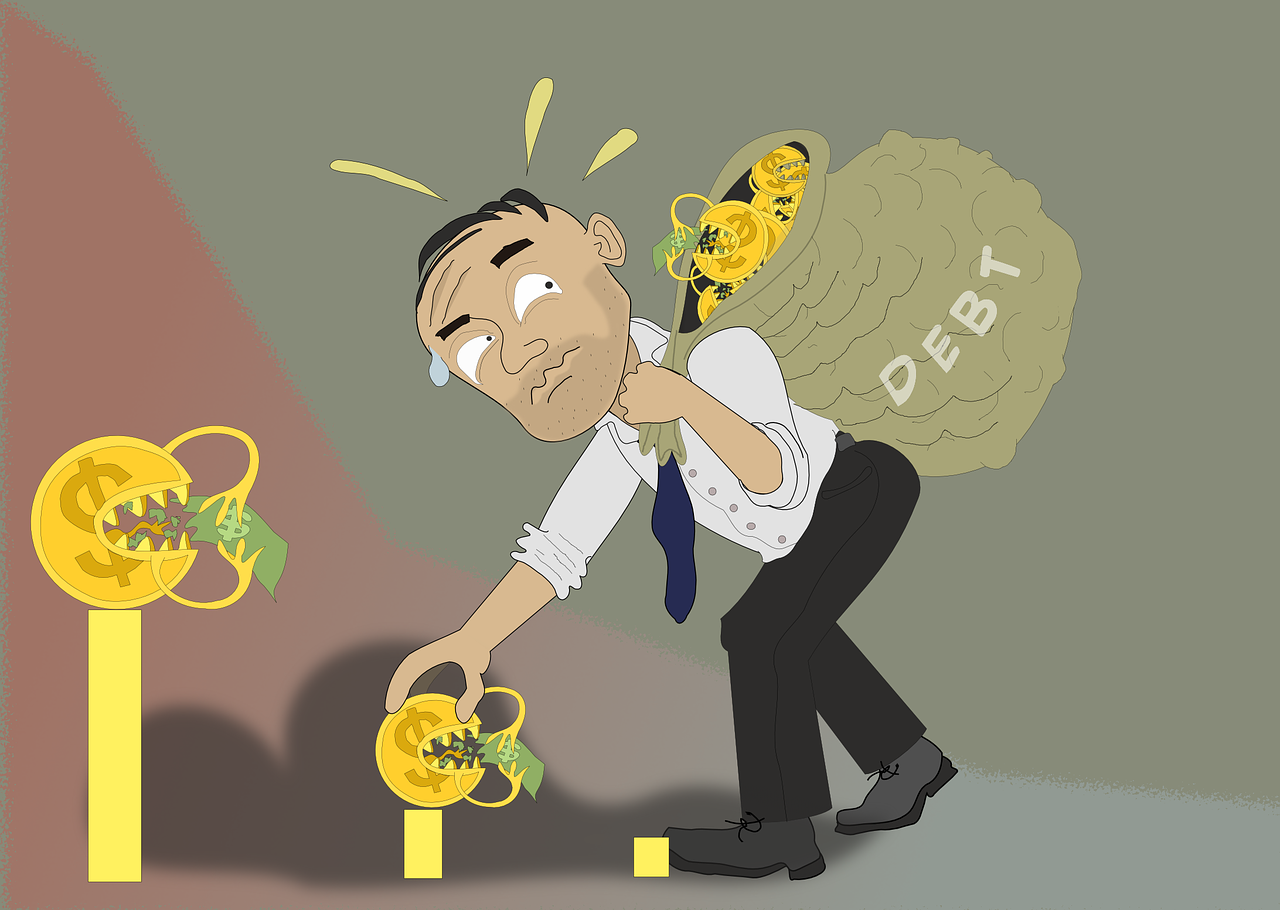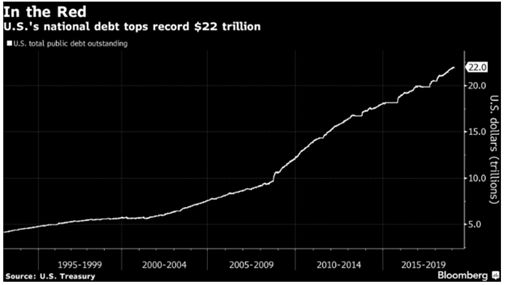FORECASTS & TRENDS E-LETTER
by Gary D. Halbert
February 19, 2019
Q4 hedge fund letters, conference, scoops etc

IN THIS ISSUE:
- National Debt Soars Above $22 Trillion, A Record High
- Debt Continues to Explode, But No One Seems to Care
- At Some Point, National Debt Will Hurt Economic Growth
National Debt Soars Above $22 Trillion, A Record High
The national debt surpassed $22 trillion for the first time on Monday, February 11, a milestone that experts warned is further proof the country is on an unsustainable financial path that could jeopardize the economic security of every American.
The Treasury Department reported last week that the debt hit $22.01 trillion, a jump of more than $30 billion in just one month. Yet we heard very little about it in the media. As a result, many Americans are not aware that the national debt is now above $22 trillion.
The national debt rose at the fastest pace in history during the Obama administration, from $10.63 trillion when he took office in January 2009 to $19.95 trillion when he left in January 2017 and continues to rise rapidly under President Trump. The US has added more than $1 trillion in debt in the last 11 months alone, the fastest pace ever.
Sadly, the Congressional Budget Office projects that annual budget deficits will top $1 trillion a year every year starting as early as 2020.
Even worse, lawmakers don’t seem to care. Regardless which party is in control, Congress increases federal spending every single year with seemingly no concern about the size of the budget deficit or the national debt. Likewise, the American people seem to be oblivious to the exploding national debt as well (more on this below).
At some point, our ballooning national debt will drive up interest rates for businesses and consumers. Higher rates can ripple through the economy, pushing up rates for mortgages, corporate bonds and other types of consumer and business loans.
The main drivers of the explosion in debt are the aging population, rising healthcare costs, growing interest payments on the debt and, arguably, a tax code that fails to generate sufficient revenue. The bottom line, though, is the fact that our government is too big and spends too much money. And it gets worse every year.
I’ve been warning about the size of our national debt for over 30 years. I’ve warned that it could lead to a debt crisis and a prolonged economic recession or worse. So far, I’ve been wrong. We had a financial crisis in 2008-09, but it was not due to our ballooning national debt; it was sparked by the bubble in low quality home mortgages, not the national debt.
While I’ve been warning about the explosion of our national debt for over 30 years to no avail, I still believe I will be correct at some point – and I think we are getting closer to the breaking point.
I have to admit, however, that those of us warning about the national debt are getting fewer and fewer. What we’re seeing now is a significant increase in those in Washington and elsewhere who believe there should be no limits on the national debt. “Just print the money,” they tell us.
But I still think I’m right to be concerned. I believe you should be concerned as well.
Debt Continues to Explode, But No One Seems to Care
As noted above, there was hardly any reaction in the mainstream media following the Treasury Department’s announcement last week that our national debt had topped $22 trillion, the highest in history.
I made a point to ask numerous friends and co-workers if they knew what the national debt has risen to as of last week. Not one of them knew it had risen above $22 trillion. Only one said he remembered hearing about it after I told him what last week’s staggering number was.
My point is, most of our leaders don’t care about the national debt anymore. Apparently, they think, the bigger the better. Why else would they consistently increase it every single year? As for the American people in general, I would stop short of saying they purposely ignore the level of debt, but I will say that most don’t seem to care anymore.
The question is, how can this be? Let’s start with lawmakers in Washington. For many years, most of our legislators in Washington have known, in their heart of hearts, that we can’t go on spending beyond our means and running up the national debt every year. They know this movie ends very badly at some point. It always does.
But more importantly, what both Democrats and Republicans actually fear more are the highly unpopular steps – spending cuts or tax increases, or both – they would have to take to reduce or eliminate annual deficits, which are huge issues with the voters. So, they take the easier option of increasing spending every single year.
Sadly, many of the lawmakers currently in Washington know nothing different. The national debt has gone up every year throughout their adult lives. The last time we had a balanced budget was 20 years ago in 1998 when Bill Clinton was president. Many of today’s congressmen and women don’t remember that.
As noted above, most Americans don’t keep track of the national debt. Surveys continually show that the national debt is not on their screen when it comes to most Americans’ concerns about the economy or their personal finances. History is replete with examples where societies ignored unsustainable debt levels until it was too late to reverse it.
At Some Point, The National Debt Will Hurt Economic Growth
Let’s look at some different numbers. The US economy, as measured by gross domestic product, was estimated by the Commerce Department to be apprx. $20.7 trillion in the 3Q of last year. Since it is widely believed that the economy expanded again in the 4Q of last year, let’s call it $21 trillion.
With the national debt now at over $22 trillion, our national debt-to-GDP ratio is over 100%. There have been countless studies over the years which conclude that when the debt-to-GDP ratio gets above 90%, a slowdown in economic growth follows not long thereafter.
In a widely-acclaimed study in 2012, economists Carmen Reinhart and Kenneth Rogoff looked at debt-to-GDP ratios above 90% in advanced economies going back to 1800. They concluded that debt levels above 90% resulted in economic growth that was 1.2% lower than in other periods on average. That’s huge!
As discussed above, we believe the US economy grew slightly above 3% last year. If our national debt-to-GDP ratio is now above 100%, that could subtract even more than 1.2% from annual economic growth before long. That could take GDP growth below 1.8% in the years just ahead. That puts us back to Obama-era anemic growth or worse!
Taking more than a full point off of annual economic growth and compounding it over a quarter century is the difference between a rip-roaring economy and rising standards of living, as we have now, and what we’ve witnessed for most the last 20 years or so.
At the end of the day, the obvious question is: What do we do about it? Unfortunately, there are no easy answers. Actually, that’s not entirely true. The answers are quite straightforward. It’s the policies that would be required to fix the problems that are very difficult, if not politically impossible at this point.
Our leaders are not willing to acknowledge that if we continue our current debt trends, things will end badly, as they always do. Thus, they refuse to take unpopular actions to avoid a crisis. The American people, for the most part, are oblivious to the danger we face, and demand more and more benefits from the government.
If you had asked me 30 years ago, when I first started warning about the national debt, if I thought the country could go from a few trillion to $22 trillion in debt, I would have said, No Way! But here we are, and it will almost certainly get worse before it gets better.
There are more and more academic theorists these days who believe there is virtually no limit to how high our national debt can rise. We owe it to ourselves, they say, so it doesn’t matter.
While I’ve been wrong for a long time, and we continue to rack-up debt at a record rate, that does not mean we won’t hit the “brick wall” at some point. I’ve given up predicting when that point will come, but I still have no doubt that day is coming. There is a limit to everything.
At the end of the day, I am so sad that this is the future we are leaving to our children! My generation has been aware of this problem throughout our adult lifetimes. We should have, and could have, stopped this. But we didn’t. We continued to elect and re-elect politicians who vote to spend more every year. That will be our legacy.
I hate to have to say it, but it’s true.
Best regards,
Gary D. Halbert
SPECIAL ARTICLES


